ABSTRACT
Sawdust is a major ingredient for cultivation of edible mushrooms. In Taiwan, the annual demand of sawdust for mushroom production has increased to more than 350,000 tons in recent years. Using sawdust for mushroom production is not only expensive but is also harmful to the ecosystem. An estimated 300,000 tons of spent mushroom substrates were produced annually in Taiwan during the decade. Most of the spent mushroom substrates, which are nutrient-rich and containing lignin, cellulose, hemicellulose, or mushroom metabolites, still can be reused as ingredients of the substrate formula for agricultural production. This topic mainly focuses on the production using the spent mushroom substrates. These technologies are about mushroom cultivation, vegetables cultivation in facilities, formulation of cultivation medium (organic certification), gardening cultivation vermicomposting, breeding of paddy rice turf, etc. To assess the availability of fresh spent king oyster mushroom (Pleurotus eryngii) substrates (FSKOMS) for mushroom production, the production capacities of phoenix-tail mushroom (Pleurotus sajor-caju), Bunashimeji (Hypsizygus marmoreus), and sunny mushroom (Agaricus braziliensis) were investigated by growing them on the growth substrates made of individuals or mixture of fresh sawdust (FS) and FSKOMS. The results showed that yields of these three tested mushrooms in the growth substrates containing FS and FSKOMS at 1:1 ratio (w/w, dry weight) were higher or not significantly different from those of the treatment using FS alone. Another test was to assess the availability of composted spent king oyster mushroom substrates (CSKOMS) for the production capacity of king oyster mushroom by replacing fresh sawdust as the ingredient. Yield of king oyster mushroom in the treatment of FS and CSKOMS at 1:1 ratio reached nearly 80% of the yield of the treatment of FS alone. Furthermore, to assess the availability of spent shiitake substrates, the production capacity of lettuce, strawberry seedling and strawberry fruit were investigated by growing them in the growth substrate mixtures made of different ratios of spent shiitake substrates, rice hulls, and peat moss. The yield of lettuce, the leaf fresh weight and root fresh weight of strawberry seedlings, and the weight of strawberry fruit in the treatment of 1:0 ratio (peat moss alone) was the highest. The yield of lettuce, the leaf fresh weight and root fresh weight of seedling of strawberry, and the weight of strawberry fruit in the treatment of substrate peat moss alone were the highest when compared with those in the treatment of peat moss and spent shiitake substrates at 1:1 ratio, and those in the treatment of rice hulls and spent shiitake substrates at 1:1 ratio, all of which can reach the yields around 80% of those in the treatment of peat moss alone. Moreover, the spent mushroom substrates can be reused for many agricultural benefits. For example, the spent mushroom substrates can also be digested by earthworms into vermicompost for further uses beneficial for circular economy. By use of different cultivation substrates, made of compost of spent mushroom substrates, rice straw or sawdust, the seed germination rates of coughgrass in different compost formulas were around 10 % higher than that in the original cultivation substrates; the rooting percentage of field aster cutting propagation could reach to 90 %. In this research project, there were some products developed as follows. The first one, Mushroom-bag medium soil improvement materials: a technology module for adding Trichoderma fermentative inoculant at the right time during the treatment of the spent mushroom substrates. It can produce stress-resistant materials and improve crop yield and quality. The second one, Deodorant bedding products: using deodorant bedding for the livestock farming of chicken farms by using the mixture of spent mushroom substrates and acid-resistant probiotics. The third one, Mushroom-packed medium feed additive: the use of spent mushroom substrates and acid-resistant probiotic feed additives is mixed to develop feed additives for animal husbandry that can reduce the use of antibiotics. These researches are eco-friendly and economical. These results energized the surplus materials re-using industries in Taiwan.
Keywords: Spent Mushroom Substrates (SMS), lettuce, strawberry, vermicompost, grass blanket, Trichoderma fermentative, deodorant, feed additives
INTRODUCTION
Sawdust is a main ingredient for cultivation of edible mushrooms. In Taiwan, the annual demand of sawdust for mushroom production has increased to more than 350,000 tons in recent years. Using sawdust for mushroom production is not only expensive, but is also environmentally unsound. In recent years, 5,800,000,000 to 6,012,000,000 bags/ bottles were made in mushrooms cultivation (Table 1). In Taiwan, an estimated 300,000 tons of spent mushroom substrates (SMS) were produced annually and most of them were used as organic compost for growing crops. However, most of the SMS are nutrient rich and they are of potential for reuse in growing mushrooms. Most of the SMS contain lignin, cellulose, hemicellulose, or metabolites made from mushrooms. This topic mainly focuses on the technologies for products made from the SMS. These technologies are about the researches of SMS re-using and value-adding for mushroom cultivation, vegetable cultivation in facilities, planting organic materials (cultivation medium with organic proved), gardening cultivation vermicompost, breeding of paddy rice and grass blanket, etc.
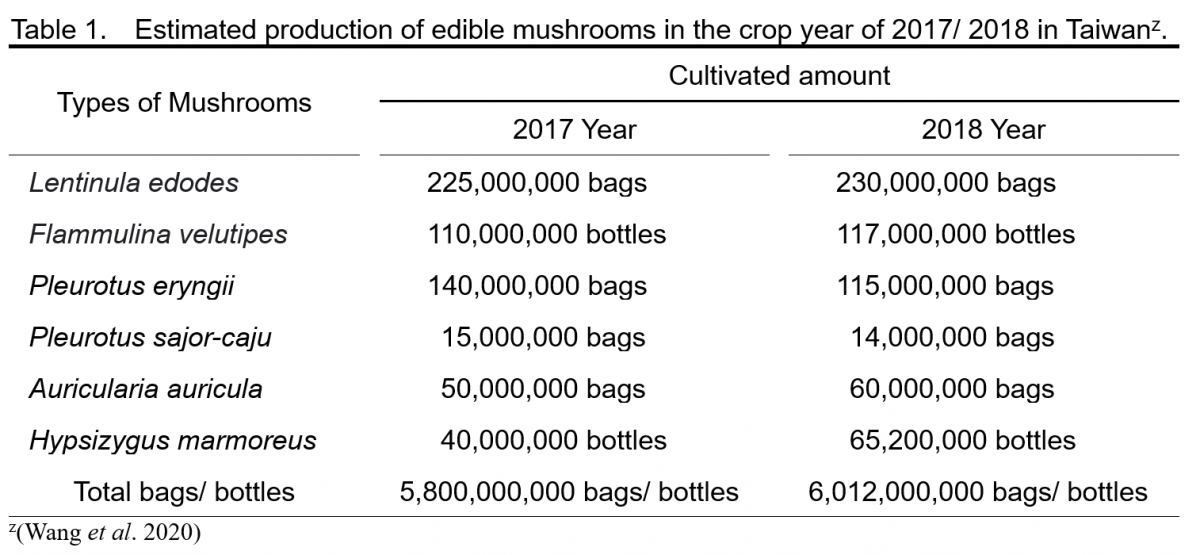
MUSHROOM CULTIVATION
SMS is used to identify its effects to re-use mushroom cultivation. King oyster mushroom, the second large scale cultivated mushroom in Taiwan, which is just harvested one time and the spent substrates of it is still nutrient rich. Fresh spent king oyster mushroom (Pleurotus eryngii) substrates (FSKOMS) collected after harvesting, within 3 days, were used as an ingredient in the growth substrates to determine the feasibility of production of phoenix tail mushroom (Pleurotus sajor-caju), Bunashimeji (Hypsizygus marmoreus), and sunny mushroom (Agaricus braziliensis). The ratio of fresh sawdust and FSKOMS in the growth substrates was 2:1, 1:1, 1:2, or 1:0 (w/w, dry weight) for the production of phoenix tail mushroom and Bunashimeji; and 1:0, 2:1 or 1:1 (w/w, dry weight) for the production of sunny mushroom. Results showed that yield of phoenix tail mushroom in the growth substrates containing fresh sawdust and FSKOMS at 1:1 or 1:2 ratio was not significantly different from the treatment of 1:0 (fresh sawdust alone). The yield of Bunashimeji in the treatment of fresh sawdust and FSPES at 1:1, 2:1, or 1:2 ratio (w/w, dry weight) was higher than the treatment of 1:0. For sunny mushroom, yield was the highest in the treatment of fresh sawdust and FSKOMS at 1:1 ratio (w/w, dry weight). These results suggest that the FSPES can be used to replace fresh sawdust for production of phoenix tail mushroom, Bunashimeji and sunny mushroom and the optimum rate of FSKOMS for mushroom production varies with mushroom species. In addition, the use of FSKOMS will reduce the demand of fresh sawdust and, thereby, reduce the mushroom production cost and improve environmental health.
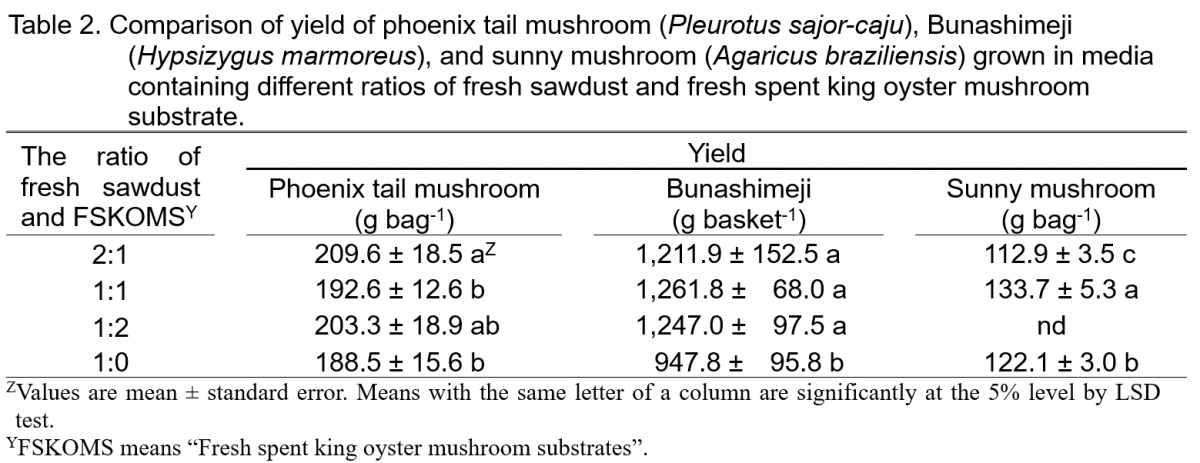
Besides using FSKOMS for testing, replacing fresh sawdust using composted spent king oyster mushroom substrates (CSKOS) is also used to determine the producing ability for king oyster mushroom. Yield of king oyster mushroom in the treatment of fresh sawdust and CSKOMS at 1:1 ratio reached nearly 80% of the yield of the treatment of 1:0. In order to develop more ways for re-using CSKOMS, the producing ability of wood ear by replacing fresh sawdust using CSKOMS was also tested. Yield of wood ear in the treatment of fresh sawdust and CSKOMS in 1:1 ratio was very similar to that in the treatment of 1:0 (Fig. 1).
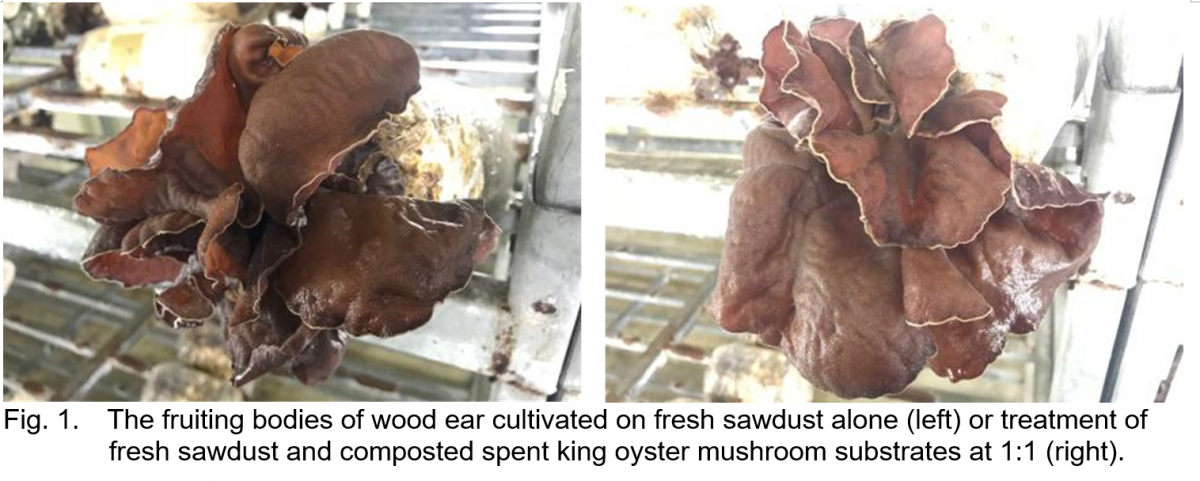
VEGETABLES CULTIVATION IN GREENHOUSES
According to the statistics from the Taichung City Agriculture Bureau, there are about 260,000,000 bags of shiitake mushrooms produced and discarded each year in the Xinshe district, Taichung. The spent shiitake mushroom substrates (SSMS) are not suitable for plant growth due to high pH and poor aeration. For vegetable cultivation in the greenhouses, the pH, conductivity (EC) and nitrogen efficiency of substrates are important factors to plant growth. The media analysis of SSMS, rice hulls and peat moss showed (Table 3) that the pH of SSMS was 8.96, rice hulls and peat moss were nearly 6.0, and EC was 1.07, 1.19 and 0.45 m S cm-1, respectively, with nitrogen efficiency was 151.4, 0, 3.85 mg kg-1. The pH of SSMS was partial alkaline, could be reduced to pH 6-7 by 2-3 times washing method. After SSMS are treated, it could be used for growing vegetables and strawberry seedlings in summer, which could improve the additional value of SSMS and reduce the amount of wastes.

To improve the aeration of SSMS, peat moss or rice hulls mixed with SSMS at ratio 1:1, and SSMS, peat moss and peat moss mixed with rice hulls at ratio 1:1 were tested. The yield of lettuce grown in the treatments of peat moss was highest, whereas that in the treatments of SSMS was the lowest (Fig. 2). The yields of lettuce grown on with the treatment of peat moss and SSMS at 1:1 ratio (w/ w) and the treatment of SSMS and rice hulls at 1:1 ratio (w/ w) were more than 80% of the yield of that with the treatment of peat moss and SSMS at 1:0 ratio (w/ w). The result showed that SSMS mixed with peat moss could be used as a media for lettuce growth.
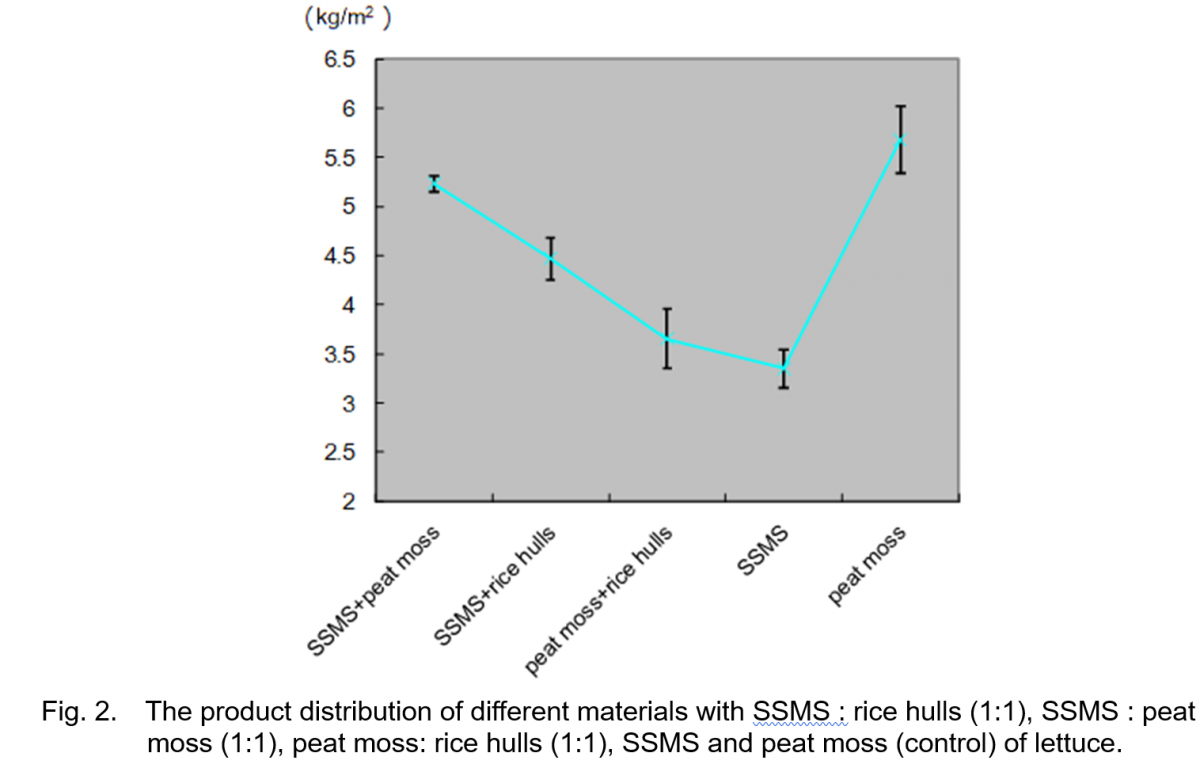
The investigation of the strawberry seedlings (Taoyuan No.1 and Sagahonoka), after breeding about 2 weeks later showed that the weight of fresh leaves and roots of the seedlings harvested from the substrates only containing SSMS and rice hulls at 1:1 ratio (w/w) were better than other test group (Fig. 3 and 4). The growth of Sagahonoka was less than Taoyuan No. 1. The Taoyuan No.1 strawberry fruit cultivation results show that the weight of a single fruit, except the treatment of peat moss and rice hulls at 1:1 ratio, could reach more than 95% of that harvested from the treatment only containing peat moss. The fruit cultivation of Sagahonoka from four test groups and control group were not significantly different. The results indicated that the re-using of SSMS and rice hulls can reduce the costs of new cultivated materials and reach the goal of recycling of spent materials. In this way, production costs can be reduced and industrial competitiveness can also be improved.

MULTI-CROP CULTIVATION MATERIALS
The SMS can be transformed into daily uses, decomposed effectively and quickly by earthworms (Fig. 5), moreover, it could also be beneficial for circular economy. This technology mainly aims to the products made from the pre-processed SMS with vermicompost process (Arancon et al. 2003; Arancon et al. 2004a; Arancon et al. 2004b; Dominguez, Edwards and Webster 2000; Dominguez and Edwards 2004; Eastman 1999). This product is a result of planting organic material (cultivation medium with organic proved), which can be applied to gardening cultivation. The practice is considered eco-friendly and economical. To determine the ability of cabbage cultivation, a variety of SMS were mixed in different proportions for testing. The results showed that several formulas of cabbage growth are all good enough to become commercial products (Fig. 6). On the other hand, the SMS can easily be applied to home gardening cultivation. These products energized the surplus materials re-using industries in Taiwan.
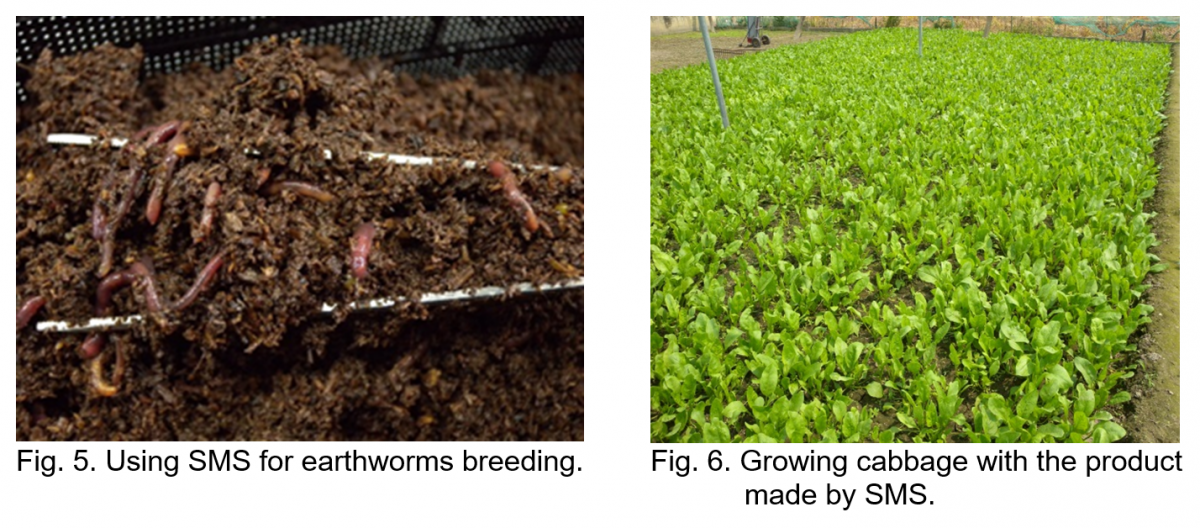
Reducing the cost of planting, increasing the utilization of agricultural surplus, and recycling the spent agricultural sources, are the main purposes of this project. In this experiment, the SMS were composted with other agricultural surplus and their physical and chemical characteristics were analyzed during and after the composting procedure. The fermentation degree during the composting procedure was also tested by the germination ratio of radish, Chinese cabbage, and lettuce in compost extracts. After composting, the SMS compost was used to mix paddy rice nursery soil or cultivation medium in different ratios to make different regenerative cultivation medium formulas for rice seedling or grass blanket.
In the rice nursery experiment, both treatments were mixed with soil in different ratios. The water retention increased, bulk density decreased, and porosity increased when the proportion of treatments A or B increased. There are no significant differences between different seedling soil formulas on water conductivity. It also showed survivability of seedlings and plant height increased with the proportion of treatment A or B. For instance, the plant height of 100 % treatment A and B was 12.1 ± 1.8 and 11.7 ± 1.8 cm, higher than CK (10.0 ± 1.6 cm). Results showed the transplanting proportion of different formulas were all higher than CK (Fig 7). It seems treatment A or B can completely substitute rice nursery soil.
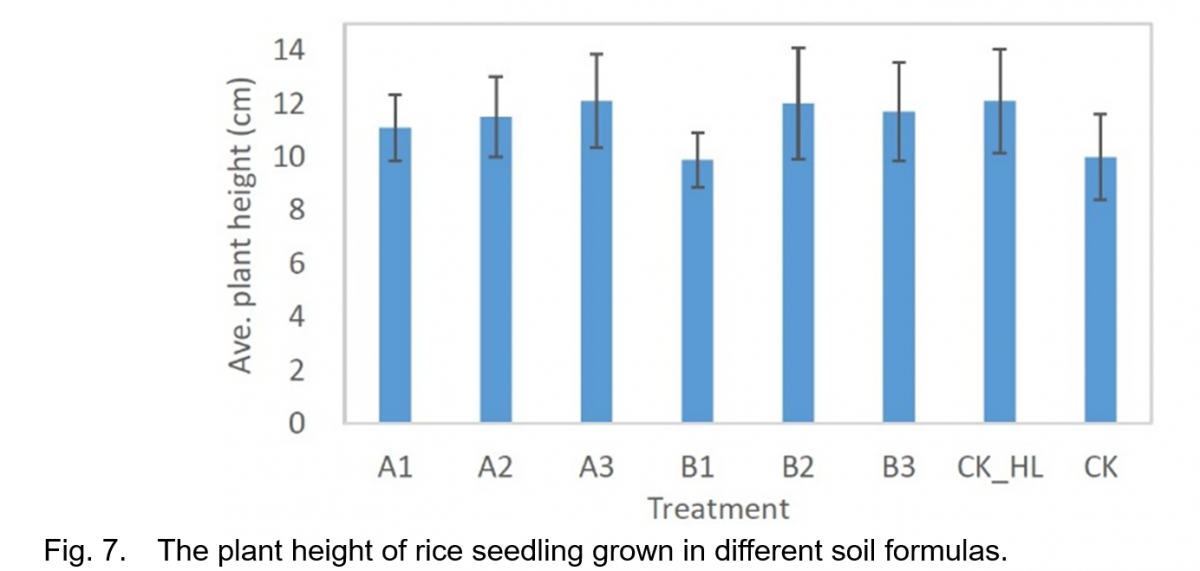
In the grass blanket planting experiment, field aster and coughgrass were used to test the feasibility of treatments A or B mixed with the cultivation medium in different ratios. Except for 100 % treatment B, the germination rate of coughgrass in different formulas (Fig. 8) was over 80 %, higher than the original cultivation medium, which was 70.14 %. As for the field aster cutting propagation in these formulas, the rooting percentage was over 90 %. After a few weeks, it also found the field aster planted in different formulas can survive for a much longer period than the original cultivation medium (Fig. 9). In conclusion, after composting, the SMS could substitute the rice nursery soil and cultivation medium. However, it also depends on the chemical characteristics of the SMS from different resources and the type of mushrooms.

APPLIED IN FIELD
In the process of mushroom and animal husbandry residual material treatment, timely addition of Trichoderma fermentative inoculant technology has developed new culture media, biological compost and soil improvement materials (Hendrix et al. 1992). It can produce agricultural residual material decomposition treatment agent and organic fertilizer to improve resource regeneration cycle and crop yield. It has improved the disaster mitigation and adaptation capabilities of crops in response to climate change, and have developed products that should be kept warm, moisturized, and maintained to improve the crop's ability to withstand flooding. Field tests have overcome the effects of extreme weather such as warm winter, low temperature, heavy rain (Table 4), and drought on crop production. In this experiment, the average mortality rate in the second area of the field investigation and treatment group was only 11.26%, while the average mortality rate in the second area of the investigation control group was 43.14%.
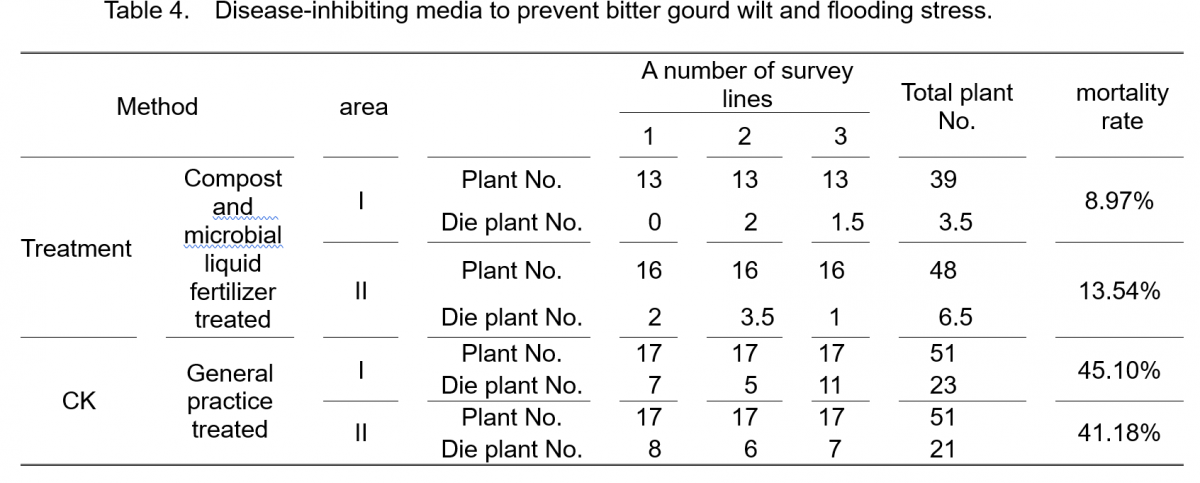
The SMS and acid-resistant probiotics are used to develop deodorant bedding and treatment agents for the animal husbandry. Chicken house deodorization and antibacterial bedding products can reduce the generation of odors in chicken farms by 80-95% (Table 5). Combined with deodorant litter and probiotic spraying, it can deodorize and reduce heat barriers in summer. The survival rate of chickens is more than 95% and the production is increased by 20%. In addition, the drying time of sawdust chicken manure can be shortened, and compost products of poultry manure can be developed (De Bertoldi et al. 1985; Boguhn, Kluth and Rodehutscord 2006).

Solar energy is used to dry the SMS, then pulverizing and mixing with acid-tolerant probiotics to develop green energy feed additives for animal husbandry. Green energy feed additives can reduce the production of odor in laying hens by 80-95% (Table 6). Combined with green energy feed additives and probiotic spraying, it can deodorize and reduce the heat barrier of the chicken house in summer. The survival rate of the chickens is more than 95%. It can save feed consumption by 25% and can reduce the use of drugs by more than 95% during feeding.

CONCLUSION
The SMS could substitute the fresh sawdust for mushroom cultivation. It also could be used to cultivate vegetables and strawberries in facilities, used to breed earthworms for vermicomposting, used as a rice nursery soil and cultivation medium. However, it also depends on the chemical characteristics of the mushroom cultivation medium surplus from different resources and the types of mushrooms. A production capacity similar to or better than the general production, perhaps can be developed through the recycling of SMS, which can reduce the costs of materials and reach the goal of recycling of spent substrates. Reducing cost may improve agricultural competitiveness. The development of optimal cultivation conditions can be done by reusing spent agricultural substrates, to promote environmental protection and agricultural sustainability. The goal of zero agricultural remains can hopefully be attained in the not so far away future.
REFERENCES
AOAC. 2000. Official methods of analysis of AOAC International,17th edition. Association of Official Analytical Chemistry. Maryland, USA.
Arancon N. Q., C. A. Edwards, P. Bierman, J. D. Metzger, S. Lee, C. Welch. 2003. Effects of vermicompost to tomatoes and peppers grown in the field and strawberries under high plastic tunnels. Pedobiologia 47:731–735.
Arancon N. Q., C. A. Edwards, R. Atiyeh, J. D. Metzger. 2004a. Effects of vermicompost produced from food waste on the growth and yields of greenhouse peppers. Bioresour Technol 93:139–144.
Arancon N. Q., C. A. Edwards, P. Bierman, C. Welch, J. D. Metzger. 2004b. The influence of vermicompost applications to strawberries: Part 1.Effects on growth and yield. Bioresour Technol 93:145–153.
Boguhn, J., H. Kluth and M. Rodehutscord. 2006. Effect of total mixed ration composition on fermentation and efficiency of ruminal microbial crude protein synthesis in vitro. J. Dairy Sci. 89: 1580-1591.
De Bertoldi, M., Vallint, G., Pera, A. and Zucconi,F.1985.Technological aspects of composting including modeling and microbiology. p.27-41. In J. K. R. Gasser. (ed.). Composting of agricultural andotherwastes. Elsevier Applied Science Publishers. London and New York.
Dominguez, J., C. A. Edwards, M. Webster. 2000. Vermicomposting of sewage sludge: effects of bulking materials on the growth and reproduction of the earthworm Eisenia andrei. Pedobiologia 44:24–32.
Dominguez, J. and C. A. Edwards. 2004. Vermicomposting organic wastes: A review. In: Shakir Hanna SH, Mikhail WZA (eds) Soil Zoology for sustainable Development in the 21st century., Cairo, pp 369–395.
Eastman, B. R. 1999. Achieving pathogen stabilization using vermicomposting. BioCycle 40:62–64.
Hendrix, P. F., D. C. Coleman, and D. A. Crossley, Jr. 1992. Using knowledge of soil nutrient cycling processes to design sustainable agriculture. Integrating Sustainable Agriculture,Ecology, and Environmental Policy 2:63-82.8. Munoz de Chavez, M., A. Chavez, V. Valles and J. A. Roldan.1995.The nopal: a plant of manifold qualities. World Rev. Nutr. Diet. 77:109-134.
Wang, G. B., W. L. Ho, Y. Z. Lee, and Z. M. Chen. 2020. Mushroom industry survey. 108 year Promoting plan for leapfrogging the domestic vegetable industries by the Agriculture and Food Agency, Council of Agriculture, Executive Yuan.


Recycling and Value-Adding of Spent Mushroom Substrates
ABSTRACT
Sawdust is a major ingredient for cultivation of edible mushrooms. In Taiwan, the annual demand of sawdust for mushroom production has increased to more than 350,000 tons in recent years. Using sawdust for mushroom production is not only expensive but is also harmful to the ecosystem. An estimated 300,000 tons of spent mushroom substrates were produced annually in Taiwan during the decade. Most of the spent mushroom substrates, which are nutrient-rich and containing lignin, cellulose, hemicellulose, or mushroom metabolites, still can be reused as ingredients of the substrate formula for agricultural production. This topic mainly focuses on the production using the spent mushroom substrates. These technologies are about mushroom cultivation, vegetables cultivation in facilities, formulation of cultivation medium (organic certification), gardening cultivation vermicomposting, breeding of paddy rice turf, etc. To assess the availability of fresh spent king oyster mushroom (Pleurotus eryngii) substrates (FSKOMS) for mushroom production, the production capacities of phoenix-tail mushroom (Pleurotus sajor-caju), Bunashimeji (Hypsizygus marmoreus), and sunny mushroom (Agaricus braziliensis) were investigated by growing them on the growth substrates made of individuals or mixture of fresh sawdust (FS) and FSKOMS. The results showed that yields of these three tested mushrooms in the growth substrates containing FS and FSKOMS at 1:1 ratio (w/w, dry weight) were higher or not significantly different from those of the treatment using FS alone. Another test was to assess the availability of composted spent king oyster mushroom substrates (CSKOMS) for the production capacity of king oyster mushroom by replacing fresh sawdust as the ingredient. Yield of king oyster mushroom in the treatment of FS and CSKOMS at 1:1 ratio reached nearly 80% of the yield of the treatment of FS alone. Furthermore, to assess the availability of spent shiitake substrates, the production capacity of lettuce, strawberry seedling and strawberry fruit were investigated by growing them in the growth substrate mixtures made of different ratios of spent shiitake substrates, rice hulls, and peat moss. The yield of lettuce, the leaf fresh weight and root fresh weight of strawberry seedlings, and the weight of strawberry fruit in the treatment of 1:0 ratio (peat moss alone) was the highest. The yield of lettuce, the leaf fresh weight and root fresh weight of seedling of strawberry, and the weight of strawberry fruit in the treatment of substrate peat moss alone were the highest when compared with those in the treatment of peat moss and spent shiitake substrates at 1:1 ratio, and those in the treatment of rice hulls and spent shiitake substrates at 1:1 ratio, all of which can reach the yields around 80% of those in the treatment of peat moss alone. Moreover, the spent mushroom substrates can be reused for many agricultural benefits. For example, the spent mushroom substrates can also be digested by earthworms into vermicompost for further uses beneficial for circular economy. By use of different cultivation substrates, made of compost of spent mushroom substrates, rice straw or sawdust, the seed germination rates of coughgrass in different compost formulas were around 10 % higher than that in the original cultivation substrates; the rooting percentage of field aster cutting propagation could reach to 90 %. In this research project, there were some products developed as follows. The first one, Mushroom-bag medium soil improvement materials: a technology module for adding Trichoderma fermentative inoculant at the right time during the treatment of the spent mushroom substrates. It can produce stress-resistant materials and improve crop yield and quality. The second one, Deodorant bedding products: using deodorant bedding for the livestock farming of chicken farms by using the mixture of spent mushroom substrates and acid-resistant probiotics. The third one, Mushroom-packed medium feed additive: the use of spent mushroom substrates and acid-resistant probiotic feed additives is mixed to develop feed additives for animal husbandry that can reduce the use of antibiotics. These researches are eco-friendly and economical. These results energized the surplus materials re-using industries in Taiwan.
Keywords: Spent Mushroom Substrates (SMS), lettuce, strawberry, vermicompost, grass blanket, Trichoderma fermentative, deodorant, feed additives
INTRODUCTION
Sawdust is a main ingredient for cultivation of edible mushrooms. In Taiwan, the annual demand of sawdust for mushroom production has increased to more than 350,000 tons in recent years. Using sawdust for mushroom production is not only expensive, but is also environmentally unsound. In recent years, 5,800,000,000 to 6,012,000,000 bags/ bottles were made in mushrooms cultivation (Table 1). In Taiwan, an estimated 300,000 tons of spent mushroom substrates (SMS) were produced annually and most of them were used as organic compost for growing crops. However, most of the SMS are nutrient rich and they are of potential for reuse in growing mushrooms. Most of the SMS contain lignin, cellulose, hemicellulose, or metabolites made from mushrooms. This topic mainly focuses on the technologies for products made from the SMS. These technologies are about the researches of SMS re-using and value-adding for mushroom cultivation, vegetable cultivation in facilities, planting organic materials (cultivation medium with organic proved), gardening cultivation vermicompost, breeding of paddy rice and grass blanket, etc.
MUSHROOM CULTIVATION
SMS is used to identify its effects to re-use mushroom cultivation. King oyster mushroom, the second large scale cultivated mushroom in Taiwan, which is just harvested one time and the spent substrates of it is still nutrient rich. Fresh spent king oyster mushroom (Pleurotus eryngii) substrates (FSKOMS) collected after harvesting, within 3 days, were used as an ingredient in the growth substrates to determine the feasibility of production of phoenix tail mushroom (Pleurotus sajor-caju), Bunashimeji (Hypsizygus marmoreus), and sunny mushroom (Agaricus braziliensis). The ratio of fresh sawdust and FSKOMS in the growth substrates was 2:1, 1:1, 1:2, or 1:0 (w/w, dry weight) for the production of phoenix tail mushroom and Bunashimeji; and 1:0, 2:1 or 1:1 (w/w, dry weight) for the production of sunny mushroom. Results showed that yield of phoenix tail mushroom in the growth substrates containing fresh sawdust and FSKOMS at 1:1 or 1:2 ratio was not significantly different from the treatment of 1:0 (fresh sawdust alone). The yield of Bunashimeji in the treatment of fresh sawdust and FSPES at 1:1, 2:1, or 1:2 ratio (w/w, dry weight) was higher than the treatment of 1:0. For sunny mushroom, yield was the highest in the treatment of fresh sawdust and FSKOMS at 1:1 ratio (w/w, dry weight). These results suggest that the FSPES can be used to replace fresh sawdust for production of phoenix tail mushroom, Bunashimeji and sunny mushroom and the optimum rate of FSKOMS for mushroom production varies with mushroom species. In addition, the use of FSKOMS will reduce the demand of fresh sawdust and, thereby, reduce the mushroom production cost and improve environmental health.
Besides using FSKOMS for testing, replacing fresh sawdust using composted spent king oyster mushroom substrates (CSKOS) is also used to determine the producing ability for king oyster mushroom. Yield of king oyster mushroom in the treatment of fresh sawdust and CSKOMS at 1:1 ratio reached nearly 80% of the yield of the treatment of 1:0. In order to develop more ways for re-using CSKOMS, the producing ability of wood ear by replacing fresh sawdust using CSKOMS was also tested. Yield of wood ear in the treatment of fresh sawdust and CSKOMS in 1:1 ratio was very similar to that in the treatment of 1:0 (Fig. 1).
VEGETABLES CULTIVATION IN GREENHOUSES
According to the statistics from the Taichung City Agriculture Bureau, there are about 260,000,000 bags of shiitake mushrooms produced and discarded each year in the Xinshe district, Taichung. The spent shiitake mushroom substrates (SSMS) are not suitable for plant growth due to high pH and poor aeration. For vegetable cultivation in the greenhouses, the pH, conductivity (EC) and nitrogen efficiency of substrates are important factors to plant growth. The media analysis of SSMS, rice hulls and peat moss showed (Table 3) that the pH of SSMS was 8.96, rice hulls and peat moss were nearly 6.0, and EC was 1.07, 1.19 and 0.45 m S cm-1, respectively, with nitrogen efficiency was 151.4, 0, 3.85 mg kg-1. The pH of SSMS was partial alkaline, could be reduced to pH 6-7 by 2-3 times washing method. After SSMS are treated, it could be used for growing vegetables and strawberry seedlings in summer, which could improve the additional value of SSMS and reduce the amount of wastes.
To improve the aeration of SSMS, peat moss or rice hulls mixed with SSMS at ratio 1:1, and SSMS, peat moss and peat moss mixed with rice hulls at ratio 1:1 were tested. The yield of lettuce grown in the treatments of peat moss was highest, whereas that in the treatments of SSMS was the lowest (Fig. 2). The yields of lettuce grown on with the treatment of peat moss and SSMS at 1:1 ratio (w/ w) and the treatment of SSMS and rice hulls at 1:1 ratio (w/ w) were more than 80% of the yield of that with the treatment of peat moss and SSMS at 1:0 ratio (w/ w). The result showed that SSMS mixed with peat moss could be used as a media for lettuce growth.
The investigation of the strawberry seedlings (Taoyuan No.1 and Sagahonoka), after breeding about 2 weeks later showed that the weight of fresh leaves and roots of the seedlings harvested from the substrates only containing SSMS and rice hulls at 1:1 ratio (w/w) were better than other test group (Fig. 3 and 4). The growth of Sagahonoka was less than Taoyuan No. 1. The Taoyuan No.1 strawberry fruit cultivation results show that the weight of a single fruit, except the treatment of peat moss and rice hulls at 1:1 ratio, could reach more than 95% of that harvested from the treatment only containing peat moss. The fruit cultivation of Sagahonoka from four test groups and control group were not significantly different. The results indicated that the re-using of SSMS and rice hulls can reduce the costs of new cultivated materials and reach the goal of recycling of spent materials. In this way, production costs can be reduced and industrial competitiveness can also be improved.
MULTI-CROP CULTIVATION MATERIALS
The SMS can be transformed into daily uses, decomposed effectively and quickly by earthworms (Fig. 5), moreover, it could also be beneficial for circular economy. This technology mainly aims to the products made from the pre-processed SMS with vermicompost process (Arancon et al. 2003; Arancon et al. 2004a; Arancon et al. 2004b; Dominguez, Edwards and Webster 2000; Dominguez and Edwards 2004; Eastman 1999). This product is a result of planting organic material (cultivation medium with organic proved), which can be applied to gardening cultivation. The practice is considered eco-friendly and economical. To determine the ability of cabbage cultivation, a variety of SMS were mixed in different proportions for testing. The results showed that several formulas of cabbage growth are all good enough to become commercial products (Fig. 6). On the other hand, the SMS can easily be applied to home gardening cultivation. These products energized the surplus materials re-using industries in Taiwan.
Reducing the cost of planting, increasing the utilization of agricultural surplus, and recycling the spent agricultural sources, are the main purposes of this project. In this experiment, the SMS were composted with other agricultural surplus and their physical and chemical characteristics were analyzed during and after the composting procedure. The fermentation degree during the composting procedure was also tested by the germination ratio of radish, Chinese cabbage, and lettuce in compost extracts. After composting, the SMS compost was used to mix paddy rice nursery soil or cultivation medium in different ratios to make different regenerative cultivation medium formulas for rice seedling or grass blanket.
In the rice nursery experiment, both treatments were mixed with soil in different ratios. The water retention increased, bulk density decreased, and porosity increased when the proportion of treatments A or B increased. There are no significant differences between different seedling soil formulas on water conductivity. It also showed survivability of seedlings and plant height increased with the proportion of treatment A or B. For instance, the plant height of 100 % treatment A and B was 12.1 ± 1.8 and 11.7 ± 1.8 cm, higher than CK (10.0 ± 1.6 cm). Results showed the transplanting proportion of different formulas were all higher than CK (Fig 7). It seems treatment A or B can completely substitute rice nursery soil.
In the grass blanket planting experiment, field aster and coughgrass were used to test the feasibility of treatments A or B mixed with the cultivation medium in different ratios. Except for 100 % treatment B, the germination rate of coughgrass in different formulas (Fig. 8) was over 80 %, higher than the original cultivation medium, which was 70.14 %. As for the field aster cutting propagation in these formulas, the rooting percentage was over 90 %. After a few weeks, it also found the field aster planted in different formulas can survive for a much longer period than the original cultivation medium (Fig. 9). In conclusion, after composting, the SMS could substitute the rice nursery soil and cultivation medium. However, it also depends on the chemical characteristics of the SMS from different resources and the type of mushrooms.
APPLIED IN FIELD
In the process of mushroom and animal husbandry residual material treatment, timely addition of Trichoderma fermentative inoculant technology has developed new culture media, biological compost and soil improvement materials (Hendrix et al. 1992). It can produce agricultural residual material decomposition treatment agent and organic fertilizer to improve resource regeneration cycle and crop yield. It has improved the disaster mitigation and adaptation capabilities of crops in response to climate change, and have developed products that should be kept warm, moisturized, and maintained to improve the crop's ability to withstand flooding. Field tests have overcome the effects of extreme weather such as warm winter, low temperature, heavy rain (Table 4), and drought on crop production. In this experiment, the average mortality rate in the second area of the field investigation and treatment group was only 11.26%, while the average mortality rate in the second area of the investigation control group was 43.14%.
The SMS and acid-resistant probiotics are used to develop deodorant bedding and treatment agents for the animal husbandry. Chicken house deodorization and antibacterial bedding products can reduce the generation of odors in chicken farms by 80-95% (Table 5). Combined with deodorant litter and probiotic spraying, it can deodorize and reduce heat barriers in summer. The survival rate of chickens is more than 95% and the production is increased by 20%. In addition, the drying time of sawdust chicken manure can be shortened, and compost products of poultry manure can be developed (De Bertoldi et al. 1985; Boguhn, Kluth and Rodehutscord 2006).
Solar energy is used to dry the SMS, then pulverizing and mixing with acid-tolerant probiotics to develop green energy feed additives for animal husbandry. Green energy feed additives can reduce the production of odor in laying hens by 80-95% (Table 6). Combined with green energy feed additives and probiotic spraying, it can deodorize and reduce the heat barrier of the chicken house in summer. The survival rate of the chickens is more than 95%. It can save feed consumption by 25% and can reduce the use of drugs by more than 95% during feeding.
CONCLUSION
The SMS could substitute the fresh sawdust for mushroom cultivation. It also could be used to cultivate vegetables and strawberries in facilities, used to breed earthworms for vermicomposting, used as a rice nursery soil and cultivation medium. However, it also depends on the chemical characteristics of the mushroom cultivation medium surplus from different resources and the types of mushrooms. A production capacity similar to or better than the general production, perhaps can be developed through the recycling of SMS, which can reduce the costs of materials and reach the goal of recycling of spent substrates. Reducing cost may improve agricultural competitiveness. The development of optimal cultivation conditions can be done by reusing spent agricultural substrates, to promote environmental protection and agricultural sustainability. The goal of zero agricultural remains can hopefully be attained in the not so far away future.
REFERENCES
AOAC. 2000. Official methods of analysis of AOAC International,17th edition. Association of Official Analytical Chemistry. Maryland, USA.
Arancon N. Q., C. A. Edwards, P. Bierman, J. D. Metzger, S. Lee, C. Welch. 2003. Effects of vermicompost to tomatoes and peppers grown in the field and strawberries under high plastic tunnels. Pedobiologia 47:731–735.
Arancon N. Q., C. A. Edwards, R. Atiyeh, J. D. Metzger. 2004a. Effects of vermicompost produced from food waste on the growth and yields of greenhouse peppers. Bioresour Technol 93:139–144.
Arancon N. Q., C. A. Edwards, P. Bierman, C. Welch, J. D. Metzger. 2004b. The influence of vermicompost applications to strawberries: Part 1.Effects on growth and yield. Bioresour Technol 93:145–153.
Boguhn, J., H. Kluth and M. Rodehutscord. 2006. Effect of total mixed ration composition on fermentation and efficiency of ruminal microbial crude protein synthesis in vitro. J. Dairy Sci. 89: 1580-1591.
De Bertoldi, M., Vallint, G., Pera, A. and Zucconi,F.1985.Technological aspects of composting including modeling and microbiology. p.27-41. In J. K. R. Gasser. (ed.). Composting of agricultural andotherwastes. Elsevier Applied Science Publishers. London and New York.
Dominguez, J., C. A. Edwards, M. Webster. 2000. Vermicomposting of sewage sludge: effects of bulking materials on the growth and reproduction of the earthworm Eisenia andrei. Pedobiologia 44:24–32.
Dominguez, J. and C. A. Edwards. 2004. Vermicomposting organic wastes: A review. In: Shakir Hanna SH, Mikhail WZA (eds) Soil Zoology for sustainable Development in the 21st century., Cairo, pp 369–395.
Eastman, B. R. 1999. Achieving pathogen stabilization using vermicomposting. BioCycle 40:62–64.
Hendrix, P. F., D. C. Coleman, and D. A. Crossley, Jr. 1992. Using knowledge of soil nutrient cycling processes to design sustainable agriculture. Integrating Sustainable Agriculture,Ecology, and Environmental Policy 2:63-82.8. Munoz de Chavez, M., A. Chavez, V. Valles and J. A. Roldan.1995.The nopal: a plant of manifold qualities. World Rev. Nutr. Diet. 77:109-134.
Wang, G. B., W. L. Ho, Y. Z. Lee, and Z. M. Chen. 2020. Mushroom industry survey. 108 year Promoting plan for leapfrogging the domestic vegetable industries by the Agriculture and Food Agency, Council of Agriculture, Executive Yuan.